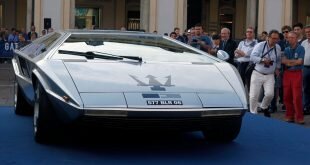Half a century of the Maserati Boomerang

It’s amazing to think that this week marks the 50th anniversary of the debut of one of the most iconic automotive concepts ever.
The futuristic Maserati Boomerang, which was created by legendary Italian car designer Giorgetto Giugiaro and produced by Italdesign, was unveiled at the Geneva Motor Show on 9 March, 1972.
It was based on a Maserati Bora, with a central eight-cylinder rear engine laid out at 90° that delivered 4,719cc. It could unleash 310hp, bringing it close to a top speed of almost 300km/h (186mph). Drive was through the rear wheels and it had a five-speed gearbox.
The two-seater sports coupé never went into production. Instead, it left behind a stylistic legacy that continued to live on not only in Giugiaro’s later creations, but also in other projects, and it served as an inspiration for other designers and manufacturers globally.
The originality of the Boomerang from an aesthetic point of view was demonstrated in its wedge shape and in its bold, clear lines, which conveyed an image of penetration, power and speed.
The model was designed along a horizontal line that divided the car in two, with a sloping windscreen and a panoramic sunroof. The original windows, especially on the two doors, were interspersed with a strip of metal. The retractable square headlamps stood out in the front, alongside the horizontal lights in the rear.
It was extremely modern in terms of its interior, where the dashboard instruments were built into the spokeless steering wheel and the seats were positioned very low.
The only specimen of the Boomerang ever produced also made other appearances in international competitions. It would change hands between various owners, ended up featuring in a number of auctions, and was even used in commercials.

